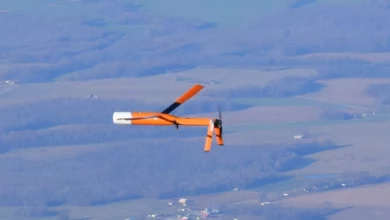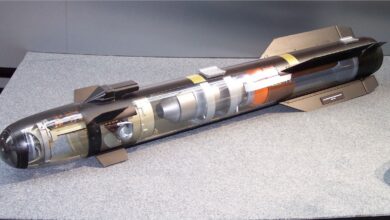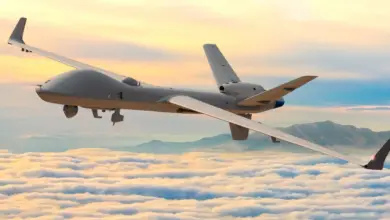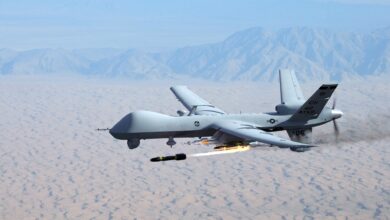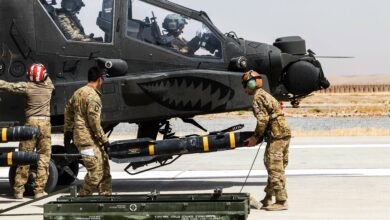AGM-114 Hellfire Missile Ultimate Guide: Capabilities, Variants, and Cost
AGM-114 Hellfire Missiles, including Romeo and Longbow, are one of the most used air-to-ground guided missiles in U.S. arsenal.
- Hellfire II Missile ''Longbow'' (Radar Guided)
- Hellfire II Missile ''Romeo'' (Multi-Purpose)
- Hellfire II Missile R9X (Minimizing Collateral Damage)
- Next Generation Joint Air-to-Ground Missile (JAGM)
- Hellfire II Missile Costs
The AGM-114 Hellfire missile is one of the most popular short-range air-to-ground (sometimes air-to-air) laser-guided, subsonic tactical missiles used by the US military as well as 30 US allies. The missile is used to target armored vehicles, including tanks, bunkers, radar systems and antennas, communications equipment, soft targets, or hovering helicopters. It has 12 variants.
The missiles have been widely used against high-profile terrorist targets and were used heavily in two Iraq wars, Yemen, Somalia and Afghanistan. Although originally designed for helicopters, they can now be launched from air, sea and ground platforms.
Today’s much-improved version of Hellfire missile was first introduced in 1996, but its development and usage dates back to the 1970s and 80s, when the US accelerated its development of Hellfire missiles to possibly use them against Soviet tanks and ground armored vehicles in the event of a possible Soviet invasion of Europe.

The Hellfire — HELiborne, Laser, FIRE and Forget Missile — was first developed to target tanks for the AH-64 Apache attack helicopter, but it is now used by fixed-wing aircraft, helicopters, UAVs, ground and sea vessels, and land-based sites.
The Hellfire family of missiles includes Hellfire II (AGM-114) and Hellfire Longbow (AGM-114L), as well as different variants of these missiles.
Hellfire II is a precision strike, Semi-Active Laser (SAL)-guided missile. It is used by Army AH-64 Apache, OH-58 Kiowa Warrior, MQ-1C Gray Eagle Unmanned Aircraft System (UAS), Special Operations aircraft, Marine Corps AH-1W Super Cobra, and Air Force Predator and Reaper UAVs.
AGM-114L Hellfire Longbow Missile
The AGM-114L, also known as Hellfire Longbow, is a precision strike missile using Millimeter Wave (MMW) radar guidance. It has the same anti-armor warhead and has the capability to operate in poor weather conditions, and provides beyond-line-of-sight, fire-and-forget capability. It uses radar to track targets by transmitting pulses of low-frequency electromagnetic waves that are reflected off the target.
The Hellfire Longbow is the only air-to-ground missile in the US military that has self-guided capability. The production of the Hellfire Longbow stopped in 2005, but the inventory will be used by 2025.
Lockheed Martin said in its 2020 report that it delivered 100,000 AGM-114 Hellfire missiles around the world.
AGM-114R Hellfire Romeo Missile
In 2010, the US Army began producing the AGM-114R, also called ”Hellfire Romeo,” which can be used against soft, hard and enclosed targets. The Romeo variant included the capabilities of all previous Hellfire missile variants and could engage targets that previously needed multiple Hellfire variants. It can be launched from higher altitudes than previous variants and with its new multi-purpose warhead a single fire can destroy a target.
AGM-114 R9X Hellfire Missile AKA Ninja Bomb
Another variant of the Hellfire missile family, first reported by the WSJ, is AGM-114 R9X, also known as the ”Ninja Bomb.” This specially designed missile is intended for surgical strikes with minimal collateral damage by cutting through houses or car roofs with its six long blades that deploy seconds before the impact.
Hellfire II Missile Specifications and Application Platforms
AGM-114L Hellfire Longbow has a range of 8,000 meters and have fire-and-forget capability. It is using Millimeter-Wave (MMW) radar seeker and can operate in adverse weather conditions with battlefield obscurants. It weighs 108 lb and measures 71 inches. The production started in 1995, ended in 2005 and the US has inventory until 2025.
AGM-114R Hellfire II or Hellfire Romeo also has 8,000 meters range, using semi-active laser homing. It weighs 108 lb, has subsonic speed, and its length is 5 ft 11 inches.

JAGM: Joint Air-to-Ground Missile
The next generation of aviation-launched, air-to-ground, self-guided missiles that will replace the Hellfire missiles is the Joint Air-To-Ground-Missile (JAGM).
With JAGM, targets could be struck day or night in adverse weather and blurred battlefield conditions from a safer distance (farther away) than current missiles. The new missile will have an improved fire and forget capability, will be able to hit moving targets, strike in adverse weather conditions, and have improved operational flexibility.
How Much Do AGM-114 Hellfire Missiles Cost?
There is specific information about the cost of Hellfire II missiles. Pentagon contracts vary across years, purchasing armies, and variants. We reviewed all Hellfire II missile sales to foreign countries since 2010 that were publicly available and concluded that the average unit cost, which also includes training and technical support, is between $130,000 and $160,000.
The Pentagon commissioned 2,109 Hellfire II missiles in 2015, including Romeo and training models, at $150,000,000, which puts the average price of each missile unit at over $71,000. But these prices almost double when the program includes training support, technical support, spare and repair parts as well as logistical support.

The State Department approved in 2015 the sale of 1,000 AGM-114 Hellfire II missiles to Lebanon at $146 million, which puts each unit at $146,000. But the sale also comes with repair and return, spare and repair parts, support equipment, documentation, personnel training and equipment, logistics and technical support services.
In 2016, the US sold the United Arab Emirates 4,000 AGM-114 R/K Hellfire Missiles, including training and technical assistance. The overall total estimated cost was $476 million, which puts each unit at $119,000. Back in 2011, the UAE purchased 500 AGM-114R3 Hellfire missiles and associated equipment, training and logistical support for an estimated cost of $65 million. Each unit cost $130,000.
In 2017, the US sold 250 AGM-114R Hellfire II Missiles, and 24 M36E8 CATMs to the Netherlands for $34 million.

In March 2021, South Korea purchased 288 AGM-114R Hellfire missiles and technical and training support at $36 million (Avg. unit cost is at $125,000). In previous years, South Korea also purchased 400 AGM-114R1 Hellfire II Missiles, 100 ATM-114Q Air Training Missiles, and 12 M36E8 Hellfire II Captive Air Training Missiles for $81 million.
In 2020, the US sold the UK 395 AGM-114R2 Hellfire missiles with support for an estimated cost of $46 million. This puts each unit price at $116,455. In 2017, the US sold the UK 1,000 AGM-114-R1/R2 Hellfire II missiles with logistics support services and other related program support at an estimated cost of $150 million (Unit price: $150,000). In 2015, the UK purchased 500 AGM-114R Hellfire II missiles for $80 million. Unit price was at $160,000 in this sale. In 2013, the UK purchased 500 AGM-114-N4/P4 Hellfire missiles at $95 million, which puts the unit price at $190,000.

France purchased 200 AGM-114K1A Hellfire Missiles for $30 million in 2016. The unit (plus support and other related equipment) price is $150,000.
In 2015, Iraq purchased 5,000 AGM-114K/N/R Hellfire missiles and 10 114K M36E9 Captive Air Training Missiles for $800 million, which puts the unit cost at around $160,000. A year earlier, Iraq ordered 500 AGM-114K/R Hellfire missiles for $82 million. Unit cost for 2014 was $164,000.
Egypt’s 2015 purchase of 356 AGM-114K/R3 Hellfire II missiles cost the largest Arab nation $57 million. The unit price stood at $160,000.

In 2012, Qatar purchased 700 AGM-114K3A or AGM-114R3 Hellfire missiles for an estimated cost of $137 million. The unit price was $196,000.
Kuwait ordered 300 AGM-114R3 Hellfire II missiles in 2012 with an estimated cost of $49 million. The unit price for Hellfire missiles as well as technical and training support was $163,000.
Countries That Use AGM-114 Hellfire Missiles
The United States sold AGM-114 Hellfire Missiles to 30 allied countries, including half a dozen in the Middle East. These include:
Australia, Croatia, Egypt, France, Greece, India, Indonesia, Iraq, Israel, Italy, Jordan, Japan, Kuwait, Lebanon, Netherlands, Norway, Pakistan, Qatar, South Korea, Saudi Arabia, Singapore, Spain, Sweden, Taiwan, Tunisia, Turkey, United Arab Emirates, United Kingdom.



